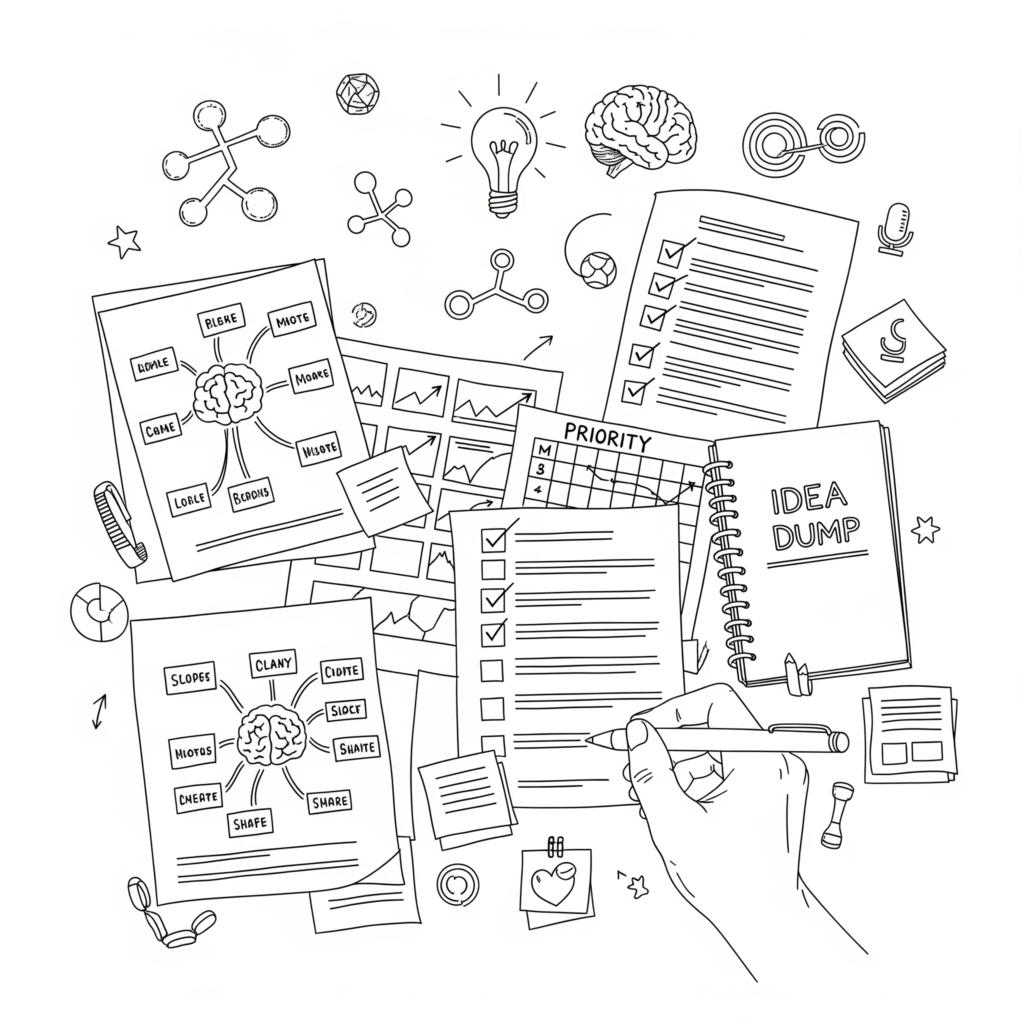How to Organize Your Ideas
In this article, we will explore effective ways to transform your flood of ideas into an organized, manageable system. Whether you’re struggling with a cluttered mind or prioritizing ideas, this article will help you streamline your creative process.
Your will learn tequiques such as; with thought-debriefing, idea categorization, and visual mapping techniques that help you see the bigger picture more clearly.
Idea Extraction Techniques:
Such techniques are very effective to use when our mind generates endless ideas to the extent that we feel distracted. These techniques aim to capture every idea that comes to mind and put it in an external place. This process relieves the burden on your mind and allows you to deal with ideas with greater clarity.
It is an essential step in organizing creative chaos. This allows you to see all your ideas tangibly instead of them remaining intertwined in your mind. Below are some of the most effective techniques for extracting ideas:
Free Writing:
Freewriting is one of the simplest and most effective ways to brainstorm. This can simply be done by opening a notebook and writing everything in your mind, without stopping or evaluating anything. For example, if you are brainstorming ideas for a book, write every single concept that the book will cover.
In this method, you shouldn’t worry about any order or rules; your mind is like a free bird that doesn’t know borders or passports.
Later, after you finish writing, you can review what you wrote, evaluate it, and see what ideas deserve more attention from you. By using this technique, you will be amazed at how your mind will be relieved after that.
- Brainstorming:
This is one of the most common ways to let ideas out, especially in work-related settings.
People hold meetings to brainstorm where they generate endless ideas without immediate evaluation, just like the free writing technique.
Brainstorming techniques are more than a way to relieve your mental stress; they are very important in the process of organizing your thoughts and turning them later into tangible projects.
This technique plays an essential role in moving you from mental chaos to a more organized phase.
- “Mind Dump”:
“Mind Dump” is a technique similar to freewriting. The only difference is that it is more organized and comprehensive. You write everything that bothers your mind and occupies it, including personal matters.
After this process, you will need to organize and prioritize your ideas. This method relieves your mental pressure and makes room for new or more focused ideas.
- Voice notes
Some people find it easier to use voice notes than writing. I prefer writing as I can focus more while writing. However, voice notes are also one of the most effective ways to write down your thoughts. In this technique, you can use your smartphone or any other specialized recording device.
This technique is especially useful when you’re on the go or when ideas come to you at inconvenient times for writing, such as while driving or walking.
Categorizing Your Ideas
There are many techniques to categorize your ideas in a way that will help you move to the next step. Let’s look at some of these techniques below:
“Priority Matrix”
This technique is quite an organized way to turn your scattered ideas into a more ordered list. For example, if you’re working on a novel, drafting the outline might be categorized as important but non-urgent, while responding to an email from your editor could fall under urgent but unimportant tasks. This Matrix consists of the following four categories:
- The first Group contains your urgent and important ideas; these ideas or tasks need your immediate attention.
- The second group contains your important but non-urgent ideas, which require careful planning.
- The third group contains your urgent, but unimportant ideas; these are the tasks that you can do without wasting a lot of time. You can also delegate these tasks to buy back your time.
- The fourth and last group contains non-urgent and unimportant ideas; these are the ideas you can simply delay or ignore.
Categorizing your ideas through this method can guarantee that you identify the most important ideas and be more focused.
- Mind Mapping:
This technique is also one of the most popular tools for visual and organized thought mapping. This is where you draw your main idea in the center and link the sub-ideas that are related to this main idea.
In his book “The Mind Map Book: Unlock Your Creativity, Boost Your Memory, Change Your Life”, Tony Buzan discussed this technique and its importance for creative individuals.
For example, if you want to create a mind map for a podcast project, you can write the phrase “launching the podcast” at the center of the board or the document you are using. Then you can surround it with branches representing sub-ideas, like “episode topics,” “guest interviews,” and “marketing strategies.” These branches can then split into smaller and more detailed strategies.
Mind mapping allows you to visually connect related ideas, helping you to identify ideas that need development or that can be linked to other projects. It is an especially powerful technique for those who have a lot of overlapping or diverse ideas.
- “List of 100”:
This technique is used when you feel that you cannot generate new ideas or when you are having trouble extracting existing ideas. You will only need to list 100 ideas that are related to your main ideas. Thus, you not only force your brain to have deeper thinking but also can look at different angles of your main idea.
Once you get past the first 20 or 30 ideas, you will start to see new patterns or angles that you hadn’t thought of before.
An example of this technique in the field of writing is: if your goal is to write a book about creativity, your list of 100 should include chapter titles, such as introduction, definition, etc.
Finally, always remember that the main goal of using the previously mentioned techniques is to create clarity and turn your ideas into reality, not to reduce clutter.
Are you a Creative with a Graveyard of Unfinished Projects?
Get Our Book On The Art of Completion
Learn How Writers and Creatives Can Finish What They Start.
This book is the essential guide to overcoming the universal struggle of creative incompletion. It contains a practical and empathetic roadmap for turning your ideas into a finished reality.



